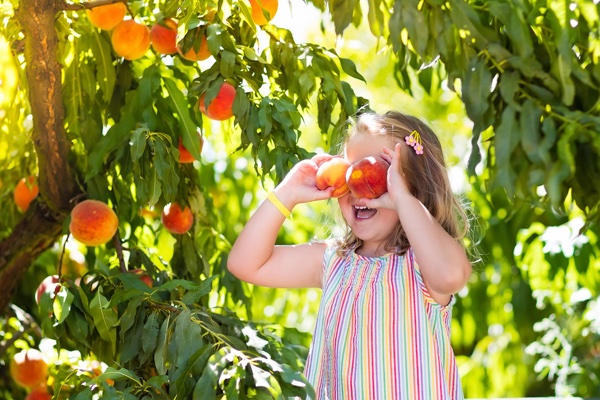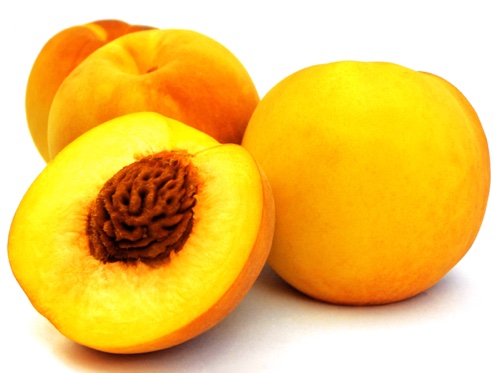That’s Just Peachy
Nothing says summer quite like a ripe, juicy, sweet peach. Go ahead – take a bite and savor that luscious burst of blossomy, fruity flavor. Add them to your favorite salads or if it’s not too hot out, bake a pie or your favorite crisp or cobbler. No matter how you slice them, peaches are the ultimate summer fruit.

In season from May through September, August is National Peach Month, the perfect time to pluck from your favorite organic grove or natural market.
A word of caution: commercially grown specimens are among the top five offenders of pesticide residue; all the more reason to buy organic.
While you’re catching the drips, here are a few facts to ponder.
Thousands of Years in the Making
That sweet little fruit has been around for centuries, is a seasoned world traveler and has survived wars and cross-oceanic trips. It dates back to 5th century BC China where it was mentioned in a collection of poetry by Confucius. Alexander the Great introduced the peach to Persia, Greece and Europe during his conquests.
The earliest surviving documentation about the peach is in the “History of Plants,” where Theophrastus (370-288 BC) refers to the “Persian apple.” The scientific name for the peach, Prunus persica, is a direct reference to the fruit’s travels to Persia along the Silk Road.
During the mid-1500s, Spanish explorers brought the peach to Mexico, and Franciscan monks introduced the peach to northern Florida and Georgia. Native Americans are credited with cultivating peaches and spreading peach seedlings from tribe-to-tribe during the 1700s. By the 1800s, peaches were so prevalent in the United States that botanist John Bartram assumed they were a native plant.
Today, the majority of the world’s peaches are grown in China, Italy, the United States, Greece and Spain.
Basic Characteristics
Amazingly enough, peaches are a member of the rose family. The flesh is either yellow or white and the color determines the flavor. White peaches tend to be sweeter and less acidic than the yellow variety. Peaches can be clingstone (the flesh sticks to the stone) and freestone (the stone is easily separated from the flesh). A different take on the peach is the donut peach, a genetic mutation with a flat top.
How to Pick a Perfect Peach
The nose knows best when choosing peaches. A perfect, ready-to-eat peach will have the fragrant scent of tree blossoms and honey nectar. A ripe peach will also have some give to it when you touch it. If it’s rock hard, it’s been picked too early and not ready for prime time. Avoid choosing peaches with brown spots and bruises.
Nutrition and Health Benefits
 The peach is a rich source of Vitamins A and C and beta carotene. Peaches are also a good source of Vitamins E, K, B1, B2, B3, B-6, folate and pantothenic acid. Peaches offer a rich array of minerals such as calcium, potassium, magnesium, iron, manganese, phosphorous, zinc and copper. A large peach has about 68 calories and 3 grams of fiber.
The peach is a rich source of Vitamins A and C and beta carotene. Peaches are also a good source of Vitamins E, K, B1, B2, B3, B-6, folate and pantothenic acid. Peaches offer a rich array of minerals such as calcium, potassium, magnesium, iron, manganese, phosphorous, zinc and copper. A large peach has about 68 calories and 3 grams of fiber.
The pigments that give the peach its rosy color are from disease-fighting polyphenols and show great promise in fighting estrogen-dependent breast cancer as well as lung cancer and colon cancer. In Hungary, the peach is known as the “fruit of calmness” and is credited with helping to reduce anxiety. Traditional Chinese medicine uses ground peach seed to treat constipation and menstrual problems. Be careful! Peach pits contain hydrocyanic acid, which is poisonous in large amounts.
More health benefits:
Nervous System: The presence of magnesium helps to prevent stress and anxiety in the body and aids in keeping the nervous system calm. A deficiency in magnesium can affect the functioning of the central nervous system. A research study to test the effect of magnesium on the nervous system suggests that magnesium-rich food and vitamin B-6 have positive effects in treating children with hyperactivity sensitivities.
Obesity: An investigative research study suggests that the presence of phenolic compounds in peaches have anti-inflammatory and anti-obesity properties that help to fight off obesity-related diabetes and cardiovascular disease.
Skin Care: Vitamin C in peaches helps you maintain healthy skin and protects you against free radicals and infections. Peaches also protect the skin against ultraviolet radiation and are widely used in skincare creams. Flavonoids, vitamins and minerals help to slough off dead skin cells and also help to hydrate the skin.
Eye Health: They’re high in beta-carotene, which helps your eyesight and prevents serious eye diseases. An investigative research study has shown that the carotenoids lutein and zeaxanthin present in the peels and pulp help to reduce the incidence of cataracts and age-related macular degeneration.
Storage
The peach is highly perishable. If your peaches are not quite ripe, place them in a paper bag, close the bag and store them for 24 hours in a dry area at room temperature, out of direct sunlight. Add a banana or apple to hasten the ripening process. Check them after 24 hours. If they have a soft scent and are slightly soft to touch, they are ready to eat. If not, keep them in the bag for another 12-24 hours until ripe.
What to Do with Them
Here are just a few of the many ways you can use peaches:
- Chop up fresh or grilled peaches in your favorite salad
- Enhance a fish or chicken recipe with fresh peaches
- Add them to your favorite ice cream recipe
- Bake a peach pie or peach cobbler
- Make peach jam
- Pickle them
And if you still have peaches left, freeze or can them. A quick and easy way to freeze peaches whole is to wash and dry them, then put them on a tray with the skins on and place the tray in the freezer. When the peaches are frozen, place them in a freezer bag and store them.
Recipe
Grilled Peaches with Honey and Goat Cheese
Recipe from Sweet Georgia Peaches
Here’s an easy side salad to make, perfect for outdoor meals. Make it a complete meal by topping fresh greens with the peach salad and adding grilled salmon or chicken.
Preparation Time: 10 minutes
Servings: 2 side salads
Ingredients
3 T. local honey
4 T. toasted pine nuts
3 large, fresh peaches with peel, pitted and sliced
2 ½ ounces of goat cheese, crumbled
Preparation
- Preheat grill to medium-high heat.
- Lightly oil grill grate. Place peaches on grill, cut side down. Cook for about 5 minutes, or until flesh is caramelized. Turn peaches over. Drizzle the top sides with the local honey and grill for another 2-3 minutes.
- Transfer the peach halves to individual serving dishes. Sprinkle with goat cheese and pine nuts.
[print-me]
